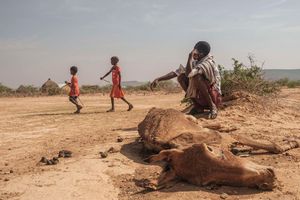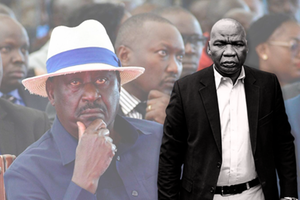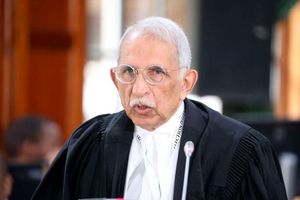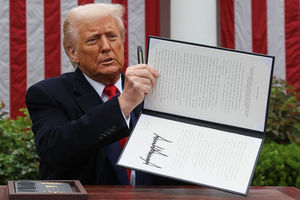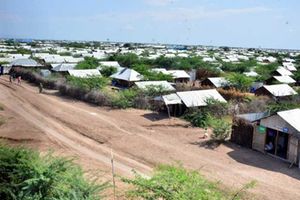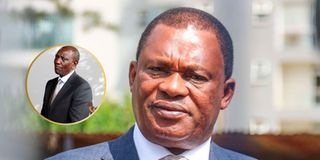
Public Service Cabinet Secretary Justin Muturi. Inset is President William Ruto.
Futures methodology, or scenarios mapping, is a dignified and scientific way to discuss hopes and fears without visiting the fortune-teller in the dead of night.
Scenarios are extrapolated possibilities, while fortune-telling attempts to predict the future, often with inexactitude. Ahead of the 2022 election, scenarios mapping had revealed much of what former Public Service Cabinet Secretary Justin Muturi has been publicly dishing out this week – that William Ruto as President would be a one-man show; that corruption would grow but be centralised around him, and that respect for institutions would suffer.
In the cacophony of election duplicity, the clarity of that message was obscured. We are just eating our desserts. Scenarios mapping burst into the sunlight 30 years ago at the dawn of a new era when Apartheid ended in South Africa.
Futures methodology was employed during the Mont Fleur Conference, bringing together youth, politicians, thinkers and business leaders to consider pathways to the future. The result has been a fairly stable and predictable South Africa over the past three decades.
Here at home, some four years later, the Institute of Economic Affairs pioneered futures methodology with its ground-breaking Kenya at the Crossroads: Scenarios for Our Future, which mapped out the option of national decline and disintegration resulting from failure to carry out political or economic reforms a decade before the post-2007 election violence.
Defining moments
Ever since, scenarios have been successfully employed to map likely outcomes at defining moments in the country’s history—such as the indictment of Uhuru Kenyatta and William Ruto at the International Criminal Court in 2012; the hung election in 2017; and the Hustler versus Dynasties electoral clash in 2022. There have also been scenarios about the management of the economy, especially debt, which make for fascinating reading and reflection.
JB Muturi, one-and-a-half-time MP for Siakago and Speaker of the National Assembly for the entirety of the 10-year Uhuru Kenyatta presidency, was a card-carrying hustler – until his son, Leslie, was abducted last year. The former Attorney General has written extensively about the steps he took to trace his son and secure his release, including a successful appeal to Ruto.
At the risk of looking a gift horse in the mouth, especially when the public is still gathering juicy details on the goings-on in the Ruto administration, several questions are still begging about Muturi’s choices: One, JB was Uhuru Kenyatta’s friend, confidante and protégé. In the decade he was Speaker, did it not occur to him that Ruto was two-faced and corrupt, or did he know all that and still go against his friends to cast his lot with the duplicitous candidate in the 2022 electoral contest? Two, where is Leslie Muturi and why is he, who was abducted, not speaking and has instead surrendered that role to his influential father? There is always a problem when a good dancer overstays the moment of his applause – it usually stops, suddenly.
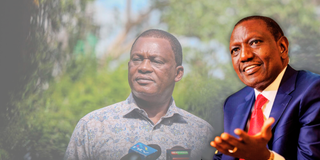
President Ruto claims Justin Muturi was fired for boycotting Cabinet meetings and being unqualified for his roles as Attorney-General and Public Service CS.
JB is the living and breathing representation of what is wrong with this country: A generation that refuses to leave the stage long after the music has stopped playing. They refuse to read the signs and hang on in the hope that they can renew themselves in readiness for the next season. There is a generational impatience with the minimum standards being upheld in leadership and it is being expressed firmly.
Notably, the President has pointed to the deficit of manners in the younger generation, but the youth have always had the same riposte to that challenge: “Those who blame this generation should remember who raised it.” This is the crisis that was so eloquently captured in another future methodology piece of work that remains relevant to date. Some 14 years ago, Katindi Sivi (now Dr) and Dr Mshai Mwangola, wrote the Kenya Youth Scenarios (Keys) for the Institute of Economic Affairs, which sought to answer the question: “What role might the youth play in influencing Kenya’s future?” The answers are prescient in hindsight. Research through conversations with the youth from Kenya’s eight regions yielded four scenarios.
One, the Tsunami, in which young people are the most disenfranchised lot, hence forming a revolutionary front, strongest in the former Coast and Northeastern provinces to fight for secession. This scenario plots an ‘African Spring’ in 2021, and the declaration of a state of emergency in 2031. Second, is the Ocean scenario – the ideal in which the country taps into the opportunity that its demographic structure provides, and can avert crisis. By 2031, the leadership begins to prepare the country for a transition to a mature population structure, determined to reap the best this opportunity has to offer.
Third, is the Pond scenario, where, like a body of stagnant water ideal for infestation, Kenya is a story of youth inertia except for those leading a secessionist movement. Bad governance, human rights abuses, and impunity breed an ungovernable country that eventually fails. “2031 finds Kenya at war and in every way, a failed state.” Fourth, is the Waterfall scenario: After intense demands by young people for job creation and economy growth, young people retreat from political participation and pursue economic success. The four scenarios suggested different paths for Kenya’s youth. The question is not whether they have happened as explained but what the country ought to do if any of those possibilities occurred.
Mr Makokha, a board member of the Kenya Human Rights Commission, writes in his individual capacity. kwamchetsi@email.com

